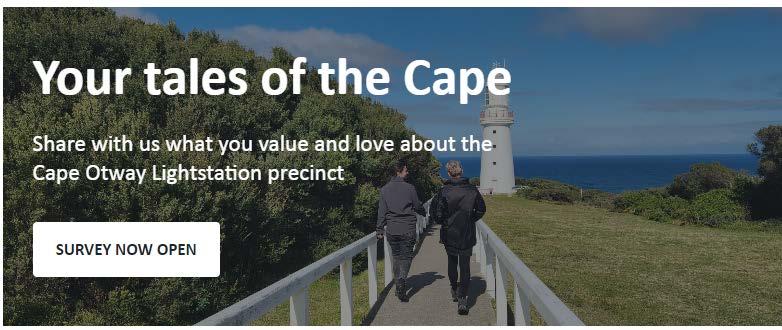TALES OF THE CAPE
COMMUNITY VALUES OF THE CAPE OTWAY LIGHTSTATION
ENGAGEMENT SUMMARY REPORT



COMMUNITY VALUES OF THE CAPE OTWAY LIGHTSTATION
ENGAGEMENT SUMMARY REPORT


We acknowledge and respect the separate and distinct Eastern Maar and Wadawurrung Peoples as the Traditional Owners of the Great Ocean Road’s land, waters, seas and skies and recognise their cultural knowledge that has led to sustainable practices and has cared for Country over tens of thousands of years.
We honour Elders past and present and express gratitude for their sharing of wisdom that has ensured the continuation of culture and traditional practices.
We are committed to genuinely partner and build meaningful relationships that reflect self-determination and enable us to work together with our Traditional Owners and Aboriginal communities to support the protection of Country, the maintenance of spiritual and cultural practices, and together deliver on their broader aspirations in the 21st century and beyond.

Otway is on the lands of the Gadubanud People, part of Eastern Maar Country,
The Great Ocean Road Coast and Parks Authority (the Authority) is immensely privileged to be tasked with protecting and enhancing the Great Ocean Road’s coast and parks on behalf of the community.
Our commitment is to listen, engage, respect, and echo the views of our community and stakeholders in all we undertake, following our Community Engagement Strategy
We’re committed to being transparent and open with our communities and building and deepening relationships grounded in reciprocity and trust. Through various channels, opportunities, and engagement spaces, we invite feedback, robust discussion, and reflection to strengthen our connections and common purpose.
The Cape Otway Lighthouse was built in 1848 and became known as the ‘Beacon of Hope’. It is a premier attraction along the Great Ocean Road, with thousands of visitors every year. It is the oldest surviving lighthouse on mainland Australia, and widely considered to be the most significant.
The lighthouse is part of a larger precinct of historic assets overseen by the Authority, including an 1859 Telegraph Station and a World War II Radar Bunker. This precinct is referred to as the Cape Otway Lightstation. The Cape Otway Lightstation precinct lies within the Otway Ranges bioregion and features a variety of ecological vegetation classes, including coastal headland scrub and coastal dune grasslands.
The Authority currently leases the Lightstation precinct from Parks Victoria and will take on land management responsibility by 1 November 2025.
During May and June 2024, we engaged with stakeholders and the broader community who value the Lightstation precinct. We wanted to share knowledge on the conservation and management of the precinct and to also gather information to help us better understand the significance of the precinct to guide future management decisions.
We invited the community to fill out an online survey asking questions about how they value the precinct and also to share stories and images that highlight their personal connection to the precinct. This report summarises what we discovered through the engagement process and how we will be responding to what we heard.
Further information on the project can be found here on the Have Your Say website.
Engagement was conducted between 27 May and 16 June 2024. To ensure we could hear from as many people
as possible we promoted the project and online survey via:
• Email sent to over 4300 stakeholder groups, community members and Lightstation visitors
• A poster in the Lightstation Visitor Centre
• Social media posts on Facebook, Instagram and LinkedIn
• Media in local newspapers
• An article on our corporate website. 4300
Have Your Say website visits online surveys submitted people reached through social posts Webpage project followers





We received 76 survey contributions. The age range of survey respondents was from 25 to 79 years old. Survey responses demonstrate that there is an active local community who value the precinct. Figure 2 below showcases survey respondents’ connection to the precinct. Those who selected the ‘other’ category were connected to the precinct through previous stays in onsite accommodation, attending events and surfing nearby.
Throughout the engagement process, respondents shared valuable knowledge, stories, and insights into how they use and value the Cape Otway Lightstation, and their aspirations for the maintenance and conservation of the area.
The survey asked all respondents to rate how significant the Lightstation precinct was to them and their family or friends. In response, 47% of respondents rated the Lightstation precinct as very significant, 43% as significant and the remaining 10% of responses rated it as neutral or low in significance. This result indicates the high value that survey respondents place on the Lightstation precinct.
WALKING AND SIGHTSEEING
VISITING THE LIGHTHOUSE
VISITING OTHER HISTORICAL PARTS OF THE PRECINCT
VISITING THE LIGHTKEEPERS CAFE
Respondents provided information on how often they visit the precinct. Only a small amount (19%) visited the precinct monthly or more, with 56% of respondents visiting occasionally, 23% only rarely, and 2% had never been to the precinct.
The table below highlights which three areas survey respondents view as most valuable in the Lightstation precinct.

Following is a summary of the key themes we heard through community feedback and, where appropriate, the Authority’s response to the issues and opportunities raised.
Survey feedback overwhelmingly displayed the high value placed upon being able to access and learn from the history of the Lightstation precinct. Many respondents were keen to impress the importance of this history including both the pre- and post-colonisation heritage of the precinct, inclusive of Aboriginal Cultural heritage, the Lighthouse, Telegraph Station, World War II Radar Bunker and associated buildings.
Respondents highlighted that there is an opportunity to expand the educational offerings on Gadubanud Culture, environmental values and the Lightstation operational history.
Example feedback:




“Putting the lighthouse and the other buildings into historical context allows you to make a connection with this precinct. I made the connection by going on all the tours to learn about the history and the people who worked and lived there. The Aboriginal cultural heritage is also extremely important and must be shared with all visitors.”









“At present the indigenous history of the precinct is missing. This is an integral part of the history of the precinct as it dates back 60,000 years and its significance is missing at present.”


Our response to what we heard:





“I love the history and stories from the area. I feel there could be more Gadubanud storytelling and information about Gadubanud country.”










“The importance of the precinct regards both First nations and colonial history. The role it played in immigration to Australia. The paradox of it being such an communicationimportant centre and now being virtually off grid via mobile technology really appeals to me.”









“As a community we need to keep and share the stories of our places and ancestors. What this place means or has meant to people, and how our Indigenous and western cultures have intersecting relationships with this place. These stories, that we are still creating as a nation, need to have their foundations shared and explored more deeply.”

We appreciate the breadth of benefits, highlighted by survey respondents, that exhibiting and educating on Aboriginal and post-colonisation heritage brings. We look forward to working alongside the Eastern Maar Aboriginal Corporation, other First Nation’s people, our valued staff, visitors, experts, and the local community in continuing to bring the true history of the site to life and making improvements where possible.

“Cape Otway Lightstation is of cultural heritage significance to Victorians and Australians. It is included on the Victorian Heritage Register and is included on the National Heritage List as part of the Great Ocean Road and Scenic Environs.”

We are committed to sharing the heritage of this precinct with all visitors. The Lightstation precinct currently provides a broad range of interpretive displays on the history of the precinct. We also run a schools education program, however, this is limited due to restricted indoor space available and the frequent inclement weather at Cape Otway.













Over its lifetime the Lightstation precinct has housed lighthouse keepers and their families, telegraph station operators, schoolteachers and air force and naval personnel. Many survey respondents expressed emotional attachment to the Lightstation precinct. This emotional attachment was particularly expressed by people that had family members living or working there, by those with a strong interest in the precinct’s history, and those who expressed nostalgia for the former lighthouse operation and its isolated lifestyle.
The Lightstation is also a cherished place for its current use, with many survey respondents expressing how highly they value visiting the precinct with family and friends. Tourists highlighted the amazing experience of connecting with a unique part of Australia’s history. Respondents from the local communities of Apollo Bay, Marengo and Lavers Hill also cited the value of this experience, as well as a personal sense of connection to the precinct, employment opportunities and the economic benefits the Lightstation provides to the region.
Example feedback:




“My family resided in the lighthouse for a few different periods of service as my Great Great Grandfather was a lighthouse keeper. His father was also a merchant seaman, so I do feel a strong sense of connection to this coastal region of Victoria.”













“The whole Lightstation package was amazing; the history, views, information boards, the wildlife, spaced out well for accommodating large number of tourists, history talks, repurposing some of the buildings for accommodation. Overall, extremely well done & was the highlight of our holiday along the Great Ocean Road.”


“Have spent happy times at the Lighthouse staying in the cottages and exploring the surrounds, it is a wonderful place to relax, learn about its history and enjoy the natural coastal environment.”



Our response to what we heard:




“The heritage nature of the accommodation took me back to my roots as the kitchen in the head keepers’ cottage was almost exactly the same as my grandmother’s house. A very happy memory.”
“Where else in the world can you eat a hot homemade scone in front of a fire while looking at the stunning vista and historical buildings during a heavy winter storm. Stunning.”




“Visiting the precinct is amazing. Spectacular views, learning about the history of the area, looking through all the buildings, and we can't forget the Devonshire Tea from the cafe. But to top all that off we stayed in the accommodation for two nights. To experience the area after hours is special.”

It is wonderful to see the high value placed on the Lightstation precinct by a broad cross section of the community. Gaining a better understanding of how and why people value the precinct will assist us in our management of the precinct. We are committed to the ongoing preservation of the Lightstation precinct and ensuring it can be appreciated and enjoyed for generations to come. We currently lease the precinct from Parks Victoria and will take on land management responsibility by 1 November 2025.
Survey responses highlighted the opportunity to enhance and value the community’s connections to the precinct.
We are aware there is an opportunity for the Authority to re-engage with the local community to support the ongoing connection of the Lightstation with the communities along the Great Ocean Road and with those who visit. This could include new volunteer groups or connecting with local schools and existing community groups or organisations. We intend to further explore these opportunities in partnership with community members who value the precinct.





Survey respondents provided many examples of where they felt the operation of the Lightstation precinct could be better. This included improving accessibility for all visitors, entry-fee affordability, improvements to communications and marketing, building and landscaping upgrades and maintenance, waste management and the provision of new toilet facilities. They also strongly advocated for the inclusion of sustainable practices into precinct operations, such as the café.
Example feedback:







“I am concerned to see this part of Victoria preserved for future generations to enjoy, with access available to all parts of the Cape and the ancient and modern history told to visitors and locals alike. It is a great day out from Apollo Bay.”







Our response to what we heard:
“Generally speaking, in my experience Cape Otway Lightstation has been mismanaged for many years. This is not for a lack of effort, but rather in my opinion due to a lack of funding. If the Victorian Government was to invest a significant amount in improving the precinct (in terms of capital, heritage approved upgrades to the buildings, the indigenous education area and education programs for schools, etc.) I believe that the precinct could become akin in success and significance to other living museums such as Ballarat's Sovereign Hill.”



“The lighthouse and buildings need maintenance that current budgets will not allow. It is possible that it will cost a lot more in the future if maintenance is not done correctly and ongoing now.”


The survey responses show us very clearly that the Lightstation precinct is very significant to many people and that there is a high degree of public interest in its for its management and future. We are committed to the ongoing preservation of the precinct and its values. To this end, we are working hard to plan and seek funding for essential works and upgrades to the existing buildings and amenities. However, we do not have plans to make any major changes to land use or buildings.
We have heard many great ideas for improvements to the precinct and will consider these carefully. We implement a green waste management system and always seek to improve our sustainability approach. This currently involves a review of our waste management strategies.
We find that most visitors to the Lightstation precinct spend an average of 1-3 hours on site and find our entrance fees excellent value for money. The fee includes entry to the extensive heritage precinct which is home to the Lighthouse, several different heritage buildings, structures and interpretative exhibits. All entry fees support the conservation of the Lightstation precinct - maintaining the grounds, buildings and structures, and employing over 20 local staff, and other efforts to protect, maintain and conserve our incredible coastline along the wider Great Ocean Road.

Some community feedback highlighted the conservation values of the Lighststation precinct and the need to prioritise their protection over increased tourism. The link between looking after environmental values and the way visitors can connect to Land, Sea and Sky Country was emphasised.
Example feedback:



“The isolation and the return of wildlife and native vegetation through the national park is an integral part of the area and its value cannot be understated, however the recent flourishing of weeds in the precinct is a worry.”









“Beautiful natural area. Great for hiking.”
“(I am concerned about) the incredible burden of environmental weeds and corresponding loss of biodiversity and amenity.”





Our response to what we heard:
The Cape Otway Lightstation precinct is surrounded by the Great Otway National Park, which contains a large range of wildlife habitat, including 43 endemic species found nowhere else in the world. It was heartening to see the large number of survey responses highlighting the importance of these values. This aligns with our commitment and ongoing work to conserve the natural values of the Great Ocean Road region. An example of this in action is that within the Lighthouse precinct our conservation team are currently managing polygala myrtifolia (myrtle-leaf milkwort). This is a South African weed species that dominates the vegetation understorey.
We acknowledge further strategic and on-ground works are required to conserve and enhance the natural values of the precinct. We are looking forward to building on our Coastal Vegetation Strategy to include areas where we have and will be taking on management responsibility.

“Distinctive, remote natural environment.”
“The wallaby welcoming us and posing for photos was the icing on the cake.”
“A great site for coastal walks, there is remedial work that needs to be undertaken eg. teatree and polygala to bring this native environment back up to scratch.”


Your helpful input has helped us better understand the way the Cape Otway Lightstation is used and valued and reinforced what a special place it is to so many. The engagement results provide an initial framework to understand community connections to the precinct and to allow us to capitalise on opportunities to increase the ties between the Lightstation and the local community, as well as appealing to less frequent visitors.
The information gathered will guide our management actions, as outlined above, and feed into any planning for the precinct. Community preferences for communications identified through the survey will direct the way we share and discuss any information on management actions with you.
Our commitment to evidence-based decision-making means that we always consider community feedback alongside Traditional Owner values and knowledge, environmental outcomes, social outcomes, and funding requirements to apply management solutions.
THANK YOU
Thank you for engaging with us on how you value the Cape Otway Lightstation Precinct. Providing your feedback helps us to better understand the key issues concerning the local community and visitors, and ensures we are listening, respecting, and reflecting community views in our management approach. We are committed to meeting the needs of the community and visitors now and for generations to come.




